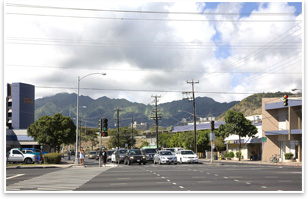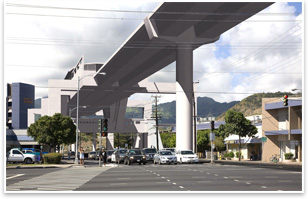|
AIA Honolulu Advocates Flexible Rail for Planned Honolulu Transit Project
by Russell Boniface
Associate Editor
Summary: AIA Honolulu is working with the Oahu City Administration and Honolulu City Council to propose a partially elevated and at-grade light rail line in lieu of a 20-mile elevated and automated rail across the entire island that would run through Honolulu, small towns, and sugar cane fields. The initially planned 20-mile Honolulu Rapid Transit project would cost $5.4 billion, not including debt financing, for a population of 900,000. AIA Honolulu’s proposal would reduce the project cost by $2 billion.

Base photo: A photo of existing conditions at
the intersection of King St. (in foreground, running right-left)
and University Ave. in Honolulu, looking northwest toward Manoa
Valley. The buildings of the University of Hawaii are in the middle
ground, the Koolau mountan range is in the background. Photograph
by Duane Preble.
The effort to redirecting the Honolulu Rapid Transit project on Oahu is based on the AIA Honolulu Policy on Transportation in support of Transportation for America's Blueprint for a 21st Century Federal Transportation Program. For the past several years, AIA Honolulu has been actively following the developing transit project and its potential impact on the city and counties of Honolulu. The AIA Honolulu Board of Directors established an AIA Transit Task Force to research and advise the board on related issues. On June 10, AIA Honolulu Executive Vice President Amy Blagriff and AIA Honolulu President Jeffrey Nishi, AIA, presented testimony to the city council in opposition of the current transit plan. A June 12 vote by the city council authorized the city to issue a $ 1.1 billion bond for the transit project.
AIA Honolulu as citizen architect
Instead of the 20-mile elevated rail system across Oahu proposed by the Honolulu Rapid Transit project, AIA Honolulu, which first became active in the transit project in 2005, suggests that 10 miles be at-grade. AIA Honolulu has always supported a transit system, but with reservations on elevated rail.
“We certainly hold a very different view as to how this project should move forward,” says Blagriff. “We believe in the power of collaboration, repeat messaging, getting the facts straight, and positioning oneself as the authoritative source. We are very aware that in order for us to succeed, we need to position ourselves so that it is a win-win for all … in other words, we know we need buy-in from a diverse group if we are to succeed in making changes. AIA Honolulu is not anti-rail.”
Blagriff says AIA Honolulu is asserting itself as informed citizen architects. “Rail has been talked about in Honolulu for over 20 years,” she says. “We have been gingerly approaching the current transit plan over the last several years.”
AIA Honolulu members met with Mayor Mufy Hannemann about the transit project in 2006 under President Michael Leineweber, AIA, and were told it was too early for architects to get involved, but that he would keep the chapter posted. “The mayor and his staff said they thought we only had been interested in station design, and that is why they had told us in 2006 it was too early,” Blagriff recalls. The next year, under President Peter Vincent, AIA, AIA Honolulu was told it was too late to make changes to the planned system. Last year, Blagriff and AIA Honolulu Past President Sid Char, AIA, met with the mayor but were told transit research was needed. Last October presided over by Char, the AIA Honolulu Board established the Honolulu Transit Task Force. A special election last November on a steel-on-steel fixed guideway system on Oahu saw a vote of 155, 800 in favor, 140,600 against, meaning it could be elevated or at-grade. The vote did not specify elevated, as is currently planned.
This year, under Nishi, AIA Honolulu has been working very hard to continue dialogue with the city administration and city council members to advocate for a flexible system capable of going at grade, particularly through the urban core. Says Blagriff: “With the help of Scott Wilson, AIA, current chair of our Transit Task Force, and Paul Louie, AIA, government affairs chair, we have been meeting with officials and allied organizations to try to gain support for our position. We believe public outreach is key to our success. I have been meeting with city officials and giving testimony, and we have been very fortunate to have Past President Sid Char, who has continued to take an active role. This continuity in leadership is key.”
In April, for Architecture Month, AIA Honolulu held a panel on transit at which 175 members of the public attended, including members of the city council. Blagriff states: “Leading up to AIA150, we were successful with our public outreach. This transit task force has been our first attempt at being as active as the chapter had been years ago. I am a convert for the Citizen Architect program because I see value in members getting more active. Elected officials need architects to advocate and share their expertise.”

This is Photo 1 overlaid with a photo simulation
of the elevated rail guideway and station proposed by the City
administration for the site. The guideway is 60 feet above grade
because it is designed to pass over the H-1 freeway, which is approximately
1/4 mile north of the photo location. Photo Simulation work by
Berkeley, Calif.-based Urban Advantage Inc.
Blagriff says the AIA Honolulu Transit Task Force has been successful because it revised its public policies on transit, which the AIA Honolulu Board approved. AIA Honolulu’s members helped to form the component’s public policy on transit, citing an e-mail survey last year asking its members their views on transit. “Any testimony that goes out is supported by our public policy,” she explains. “The policy now allows us to continue to speak if we want to give testimony. We don’t have to go back to the board.”
AIA Honolulu supports 10 miles of at-grade rail
AIA Honolulu worked with an independent transit consultant, pro bono, on its transit position and proposal. Says Blagriff: “The research shows that of the 20 miles, 10 miles would have to be elevated due to congestion. The other 10 miles can be at-grade with a driver, and that is what we are advocating. Our position focuses on the technology that the city is poised to select, which is a fully elevated, fully automated, driverless technology. The city has three RFPs and we are trying to get the city to change the RFP before the EIS [Environmental Impact Statement] has been finalized. We are advocating for a flexible, light-rail system that would save the city, according to our estimates, about $2 billion. Think of all the cement that would be needed to put in a 20-mile elevated system. In sugar canes fields it is easy to build at-grade—you don’t have to worry about rights-of-way. Also, an elevated rail would cut off ocean views from the mountains. We want to promote transit-oriented development as much as possible. But our research shows that a fully automated, driverless system is not cheaper.”
Blagriff also cites concerns such as blight under an elevated train; security and theft issues, such as those of the Vancouver rail system; and the lack of planning by the city regarding street-level interconnectivity, i.e., bus and cab pick-up areas. The chapter’s Transit Task Force is providing pro bono work to prepare visuals of how train stations in Honolulu’s Chinatown and historic district could function under its proposals.
Blagriff notes the city’s plan is to put the elevated rail in its beginning phase by starting it in sugar cane fields at the remotest part of the island and running it through little towns. “Most rail projects start at your urban core and go somewhere like a stadium or airport,” she points out. “Typically you start with a spur that people will ride to build ridership.”
The development of the Task Force under Char led to the development of a YouTube video, posted on the AIA Honolulu Web site, about the benefits of at-grade train systems, with examples of light-rail in various cities.
AIA Honolulu—a positive voice
“We are trying to position ourselves as positive forces for change,” Blagriff says. “We find we are making a difference. People are writing to the Honolulu papers saying that they support our position. We have received good news coverage. We will continue to be true to our policy and use any opportunity to testify. The final EIS is yet to be released, and we will certainly have formal comment on that. We will look for other public arenas and continue to be a voice.” |




